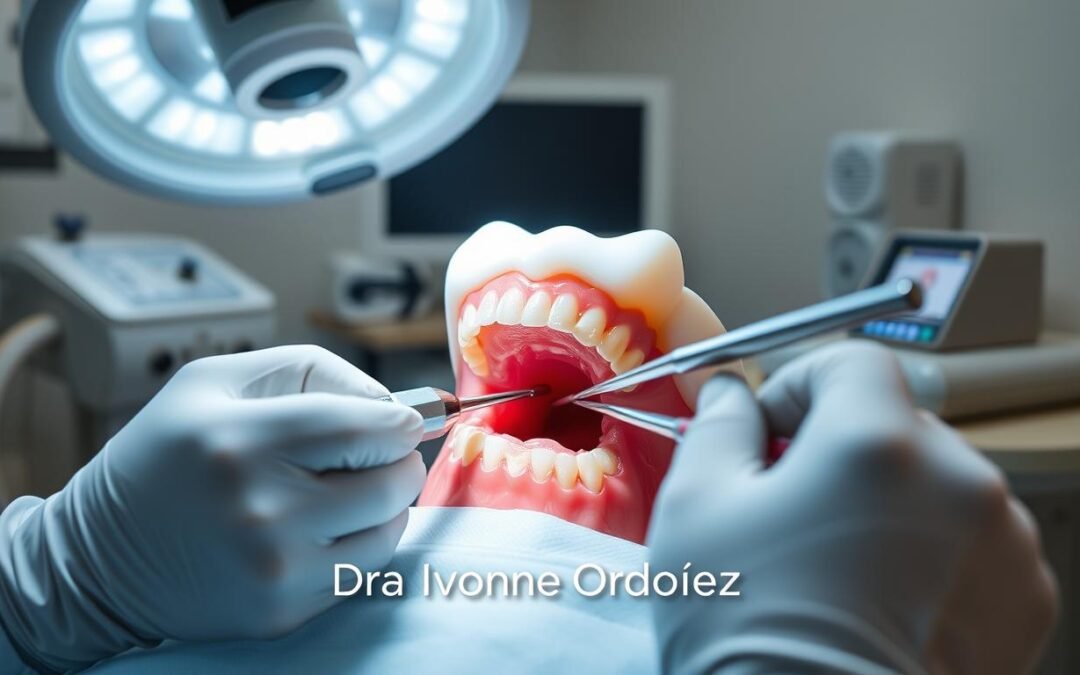Root canal treatments have hidden secrets beneath the surface. This guide reveals insights about endodontic materials and fillings. You’ll discover the elements behind successful root canal procedures.
Root canal fillings and dental sealers are vital for tooth preservation after endodontic treatments. These materials have evolved from traditional to cutting-edge techniques. They now offer improved outcomes for patients.
Endodontic materials have fascinating properties and applications. They’re crucial in modern dentistry for maintaining healthy smiles. Colombia is known for its advanced dental care services. The use of these materials, such as gutta-percha and sealers, allows for reliable endodontic treatment options that can effectively treat root canal infections and save natural teeth. Dentists in Colombia are well-versed in the latest advancements in endodontic materials and techniques, offering patients access to reliable and efficient care. This focus on using advanced endodontic materials contributes to Colombia’s reputation as a leader in providing high-quality dental services.
Key Takeaways
- Endodontic materials are essential for successful root canal treatments
- Root canal fillings have evolved significantly over time
- Dental sealers work in conjunction with fillings for optimal results
- Modern techniques offer improved outcomes for patients
- Colombia is recognized for its advanced endodontic services
- Understanding these materials can lead to better dental care decisions
Understanding the Basics of Root Canal Treatments
Root canal treatments save teeth from decay or injury. They’re a key part of endodontic services. Let’s explore why these procedures are so important.
What is a root canal procedure?
A root canal removes infected pulp from inside a tooth. The dentist cleans and shapes the root canals. Then, they fill them to stop future infections.
This treatment saves the natural tooth. It also brings back its function.
Why are endodontic materials crucial?
Endodontic materials seal cleaned canals. This stops bacteria from getting back in. The right materials ensure lasting results.
They also help keep the tooth strong.
The evolution of root canal fillings
Root canal fillings have improved over time. Early treatments used simple materials like silver cones. Now, we use advanced biocompatible materials.
These new materials bond better with tooth structure. They make root canals more effective and comfortable.
Need expert endodontic services? Have questions about root canals? Contact us on WhatsApp at +57 313 3764391. We offer personalized care and advice.
Endodontic Materials and Fillings: Types and Applications
Root canal treatments use various materials for successful outcomes. Let’s explore the types and applications of endodontic materials in modern dentistry. Endodontic materials such as gutta-percha, resilon, and various sealers are commonly used in root canal treatments. These materials help to fill and protect the tooth’s canal, ensuring a successful outcome for the patient. In addition to these traditional materials, modern dentistry is also exploring the use of Colombian root canal alternatives for even more effective and innovative treatments. These alternatives are showing promising results in providing long-term success and improved patient satisfaction.

Gutta-Percha Points are the top choice for root canal fillings. These flexible, biocompatible cones seal the canal and prevent reinfection. Dentists often pair them with sealers for best results.
Mineral Trioxide Aggregate (MTA) has become popular in recent years. This versatile material repairs root perforations and creates apical barriers. Its biocompatibility and sealing ability make it a favorite among endodontists.
Bioactive Endodontic Cements are the newest innovation in root canal therapy. These materials boost tissue growth and bond strongly with dentin. This enhances the long-term success of treatments.
| Material | Primary Use | Key Benefit |
|---|---|---|
| Gutta-Percha Points | Root canal filling | Flexibility and biocompatibility |
| Mineral Trioxide Aggregate | Perforation repair | Excellent sealing ability |
| Bioactive Endodontic Cements | Canal obturation | Tissue regeneration promotion |
The choice of material depends on the specific case. Each option offers unique advantages for successful endodontic treatments.
Gutta-Percha: The Gold Standard in Root Canal Fillings
Gutta-percha is the top choice for root canal fillings. Its special qualities make it perfect for sealing treated root canals. This material prevents reinfection and is highly valued in endodontics.
Properties and benefits of gutta-percha
Gutta-percha is safe for the body and flexible. It can shape itself to fit root canals perfectly. These features help create a tight seal in treated teeth.
Techniques for using gutta-percha in obturation
There are several ways to use gutta-percha in root canals. The most common methods are:
- Cold lateral condensation
- Warm vertical condensation
- Carrier-based obturation
Dentists pick the best technique based on each case. Their expertise also guides their choice.
Combining gutta-percha with dental sealers
Gutta-percha works best when used with Dental Sealers. These sealers fill tiny gaps between gutta-percha and canal walls. This mix creates a better seal and lowers the risk of reinfection.
| Gutta-Percha | Dental Sealers |
|---|---|
| Main filling material | Complementary sealing agent |
| Biocompatible and flexible | Fills microscopic gaps |
| Various application techniques | Enhances overall seal |
Gutta-percha and dental sealers together give great results in root canals. This trusted method has proven effective in endodontics over time.
Innovative Bioceramic Materials in Endodontics
Bioceramic endodontic materials have transformed root canal treatments. They offer unique properties that boost procedure success rates. These materials have improved patient outcomes and simplified treatments.
Bioceramics excel in biocompatibility and forming hydroxyapatite. This mineral occurs naturally in teeth, making them perfect for endodontic use. They create a strong seal between the filling and tooth.

Bioceramic materials shine in regenerative endodontic procedures. These treatments restore damaged pulp tissue function. They also continue root growth in immature teeth. Their bioactive properties spark tissue regeneration and healing.
| Property | Benefit |
|---|---|
| Biocompatibility | Reduced inflammation and faster healing |
| Antibacterial activity | Lower risk of reinfection |
| Dimensional stability | Long-lasting seal in root canals |
| Bioactivity | Promotes tissue regeneration |
Bioceramic endodontic materials have made obturation easier. They don’t need compaction, lowering the risk of root fractures. This makes them great for tricky cases with complex root canal shapes.
Choosing the Right Endodontic Materials: Factors to Consider
Picking the best endodontic materials is key for successful root canal treatments. Let’s explore important factors for choosing sealers and fillings. These include material properties, patient needs, and case requirements.
Material properties are crucial when selecting endodontic materials. Gutta-percha is popular for root canal fillings due to its flexibility and biocompatibility. Epoxy resin-based sealers offer great adhesion and sealing abilities.
Patient needs matter too. Some may have allergies, requiring different options. Case requirements also affect material choice. Complex root canals might need more flowable materials for better reach.
| Factor | Consideration |
|---|---|
| Biocompatibility | Ensures material safety for patients |
| Sealing ability | Prevents bacterial infiltration |
| Radiopacity | Allows for easy radiographic detection |
| Ease of removal | Facilitates retreatment if necessary |
Tooth anatomy and infection level guide root canal filling choices. Wide canals may need warm vertical compaction. Narrow canals might work better with cold lateral condensation.
Weighing these factors helps dentists pick the best materials for each case. This ensures the best possible treatment results for patients.
Advanced Obturation Techniques in Modern Endodontics
Root canal obturation techniques have evolved significantly in recent years. These advancements are transforming endodontic treatments, boosting success rates. Cutting-edge methods and innovative materials are improving long-term outcomes for patients.
3D-printed guides enable precise obturation, ensuring a perfect seal for root canal fillings. This technology reduces the risk of reinfection. Bioactive materials are also emerging, promoting tissue regeneration and healing.
Let’s explore some promising advanced obturation techniques:
| Technique | Description | Benefits |
|---|---|---|
| Continuous Wave Obturation | Uses heat to soften and compress gutta-percha | Excellent 3D filling of canal system |
| Carrier-Based Obturation | Gutta-percha coating on a plastic or metal carrier | Fast and efficient, especially for curved canals |
| GuttaCore | Cross-linked gutta-percha core with gutta-percha coating | Combines benefits of carrier-based and traditional methods |
| Single-Cone Technique with Bioceramic Sealer | Uses a single gutta-percha cone with bioceramic sealer | Bioactive properties, excellent sealing ability |
These advanced techniques are setting new standards in endodontics. Patients can now expect better outcomes from their root canal treatments. The future of endodontic care looks brighter than ever.
The Future of Endodontic Materials and Treatments
New materials and methods are revolutionizing root canal treatments. Bioactive Endodontic Cements are at the forefront of this change. These smart materials help teeth heal and form strong bonds with tooth tissue.
Regenerative Endodontic Procedures offer new hope for saving teeth. Instead of just filling a tooth, we can now regrow lost tissue. This breakthrough gives teeth a second chance at life.
Scientists are developing materials that mimic natural tooth structure. They’re also exploring the use of stem cells in root canal treatments. These advances promise quicker, less painful, and more successful procedures.
The future of endodontics looks bright. We’re not just fixing teeth – we’re helping them heal. It’s an exciting time in this field of dentistry.














